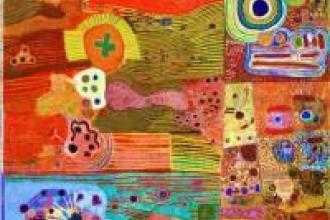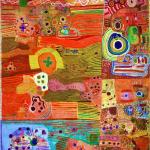
Early in 1991 the artists made several small canvases to hang outside the art centre. Later that year, whilst in Adelaide for their fist exhibition at Tandanya, they produced two large banners to be hung outside the gallery to advertise their show. The artists continued to work in this way producing the banner for the Images of Power exhibition at the NGV in 1993, several works at exhibition openings including the Bayulu Banner (purchased by the NGV in 1995), a work by a group of around 35 artists in 1996 at the NATSIAA (now held by the MAGNT), the two Ngurrara canvases (1996 & 1997), prepared as evidence for a native title claim over areas of the Great Sandy Desert, another for the Festival of Pacific Arts held in Noumea in 2000 and a canvas for the Perth International Arts Festival in 2004.
The artists involved in making these works changes with each new canvas. The Festival of Pacific Arts work titled Martuwarra and Jila (river and desert water) was a collaboration between desert and river groups, a significant work as it is the first time, as Manmarria Daisy Andrews stated, that river and desert people have worked together in this way. In contrast, the artists who worked on the Ngurrara canvases were all from the south as claimants for their native lands in the Great Sandy Desert.
The Ngurrara Canvases
In 1996 and 1997, senior artists came together to paint two huge Ngurrara canvases to be used in a land rights action brought by the Walmajarri, Mangala, Juwaliny, Wangkajunga and Manjilarra peoples now living in and around Fitzroy Crossing claiming approximately 800,000 hectares of Crown Land in the Great Sandy Desert from where they had been driven off in the 1950s and 1960s. Theses enormous ‘maps’ of country show all the ‘living’ freshwater holes of these people across the expanse of the desert. The second and larger of these canvases has been used in the hearings not only as an illustration of the claimant’s knowledge of the land, but also to assist those whose spoken English is not as fluent as the two or three indigenous languages they grew up speaking. In the hearings, claimants stood on their section of the ‘map’ and described their relationship to their land, and their relationship to the land of the neighbouring groups. In each painting, the only concession to western mapping is the depiction of the Canning Stock Route as a point of reference for those comparing the painting to a European map of the region. The Federal Court handed down the Ngurrara Native Title consent determination on November 9, 2007.
The Ngurrara canvases have attracted much attention to the land claim. They have been used in public performances where Spider Snell leads a group of dancers across the canvas in a public demonstration of the connection to the country. Spider Snell appeared dancing on the canvas in a photograph published on the front page of the Sydney Morning Herald in 2000 and currently appears on the cover of the ‘Oxford Companion to Aboriginal Art’. In February 2004, a collaborative work was produced in Perth prior to the opening of the ten year anniversary exhibition at Artplace Gallery. The Ngurrara canvases were also displayed at the same time, as part of the Perth International Arts Festival with the artists performing with local Noongar artists on top of the canvas to formally open the festival. This was another major journey for the Mangkaja artists as 42 artists travelled to Perth to perform the opening ceremony and associated events.
Martuwarra And Jila
In 2000, the Mangkaja artists painted a large collaborative canvas that shows martuwarra, the river country of its Bunuba and Gooniyandi painters, and the desert country (jila — desert waterholes) of its Walmajarri and Wangkajunga painters. Following their initial migration during the first half of last century, from their desert lands to the station country in the north, the desert people moved again in the late 1960s. The introduction of equal pay laws brought about movement away from pastoral stations and into town.
Fitzroy Crossing is located on Bunuba and Gooniyandi country. Janet Williams recalls that her father and several other Bunuba elders were asked by Walmajarri and Wangkajunga people if they could cross the river, onto their land. She says that her father welcomed them however the longing for desert lands that the old people felt is clearly expressed by a Walmajarri man, Pompey Siddon as he stated, only months before he died in 1994:
In Fitzroy Crossing we’re sitting down now in this little murnturu (island). This is Bunuba country. They are the bosses for this country, for this land. We came in from Cherrabun Station. Before that I was in the bush.
I like making these paintings because this is my country, this is my own country. We don’t go past boundaries. We are in Bunuba country. We don’t want to stop their law. We can’t do our ceremony here, it will change the law. It is deep in the ground.
With such a strong demarcation between the river and desert, it is not surprising that these artists have not worked together in the past. The cohesion amongst the individuals of what is potentially a disparate group is played out in the strength of the Martuwarra and Jila painting— in the juxtaposition of image, colour and form. This canvas reveals a significant collaboration and Daisy Andrews acknowledges this when commenting about the work:
It’s really good now how we can all sit down and work together, it’s really good, river and desert together, whole lot.



